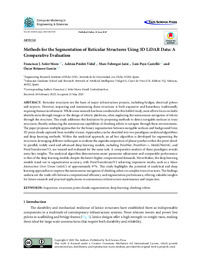Por favor, use este identificador para citar o enlazar este ítem:
https://hdl.handle.net/11000/36844Registro completo de metadatos
| Campo DC | Valor | Lengua/Idioma |
|---|---|---|
| dc.contributor.author | Soler Mora, Francisco J. | - |
| dc.contributor.author | Peidró Vidal, Adrián | - |
| dc.contributor.author | Fabregat-Jaén, Marcos | - |
| dc.contributor.author | Payá Castelló, Luis | - |
| dc.contributor.author | Reinoso García, Oscar | - |
| dc.contributor.other | Departamentos de la UMH::Ingeniería de Sistemas y Automática | es_ES |
| dc.date.accessioned | 2025-07-11T11:59:17Z | - |
| dc.date.available | 2025-07-11T11:59:17Z | - |
| dc.date.created | 2025 | - |
| dc.identifier.citation | CMES - Computer Modeling in Engineering and Sciences Volume 143, Issue 3, 30 June 2025, Pages 3167-3195 | es_ES |
| dc.identifier.issn | 1526-1492 | - |
| dc.identifier.uri | https://hdl.handle.net/11000/36844 | - |
| dc.description.abstract | Reticular structures are the basis of major infrastructure projects, including bridges, electrical pylons and airports. However, inspecting and maintaining these structures is both expensive and hazardous, traditionally requiring human involvement.While some research has been conducted in this eld of study,most e orts focus on faults identi cation through images or the design of robotic platforms, o en neglecting the autonomous navigation of robots through the structure. is study addresses this limitation by proposing methods to detect navigable surfaces in truss structures, thereby enhancing the autonomous capabilities of climbing robots to navigate through these environments. e paper proposesmultiple approaches for the binary segmentation between navigable surfaces and background from çD point clouds captured frommetallic trusses. Approaches can be classi ed into two paradigms: analytical algorithms and deep learning methods. Within the analytical approach, an ad hoc algorithm is developed for segmenting the structures, leveraging di erent techniques to evaluate the eigendecomposition of planar patches within the point cloud. In parallel, widely used and advanced deep learning models, including PointNet, PointNet++, MinkUNetç¥C, and PointTransformerVç, are trained and evaluated for the same task. A comparative analysis of these paradigms reveals some key insights. e analytical algorithm demonstrates easier parameter adjustment and comparable performance to that of the deep learning models, despite the latter’s higher computational demands. Nevertheless, the deep learning models stand out in segmentation accuracy, with PointTransformerVç achieving impressive results, such as a Mean Intersection Over Union (mIoU) of approximately ÀÞ%. is study highlights the potential of analytical and deep learning approaches to improve the autonomous navigation of climbing robots in complex truss structures. e ndings underscore the trade-o s between computational e ciency and segmentation performance, o ering valuable insights for future research and practical applications in autonomous infrastructure maintenance and inspection. | es_ES |
| dc.format | application/pdf | es_ES |
| dc.format.extent | 29 | es_ES |
| dc.language.iso | eng | es_ES |
| dc.publisher | Tech Science Press | es_ES |
| dc.rights | info:eu-repo/semantics/openAccess | es_ES |
| dc.rights | Attribution-NonCommercial-NoDerivatives 4.0 Internacional | * |
| dc.rights.uri | http://creativecommons.org/licenses/by-nc-nd/4.0/ | * |
| dc.subject | Inspection | es_ES |
| dc.subject | structures | es_ES |
| dc.subject | point clouds | es_ES |
| dc.subject | segmentation | es_ES |
| dc.subject | deep learning | es_ES |
| dc.subject | climbing robots | es_ES |
| dc.subject.other | CDU::6 - Ciencias aplicadas::62 - Ingeniería. Tecnología | es_ES |
| dc.title | Methods for the Segmentation of Reticular Structures Using çD LiDAR Data: A Comparative Evaluation | es_ES |
| dc.type | info:eu-repo/semantics/article | es_ES |
| dc.relation.publisherversion | https://doi.org/10.32604/cmes.2025.064510 | es_ES |

Ver/Abrir:
TSP_CMES_64510 (2).pdf
5,58 MB
Adobe PDF
Compartir:
 La licencia se describe como: Atribución-NonComercial-NoDerivada 4.0 Internacional.
La licencia se describe como: Atribución-NonComercial-NoDerivada 4.0 Internacional.
.png)